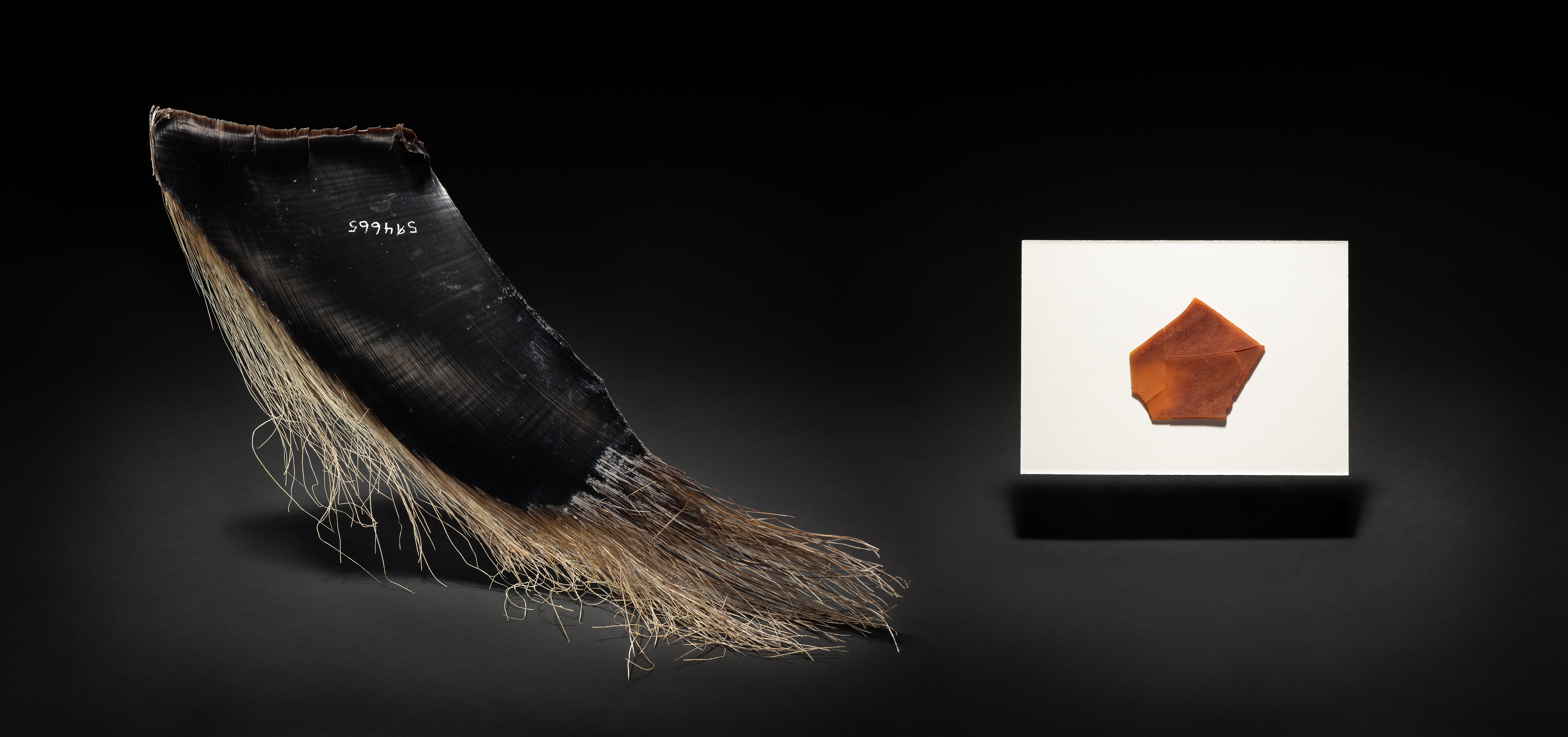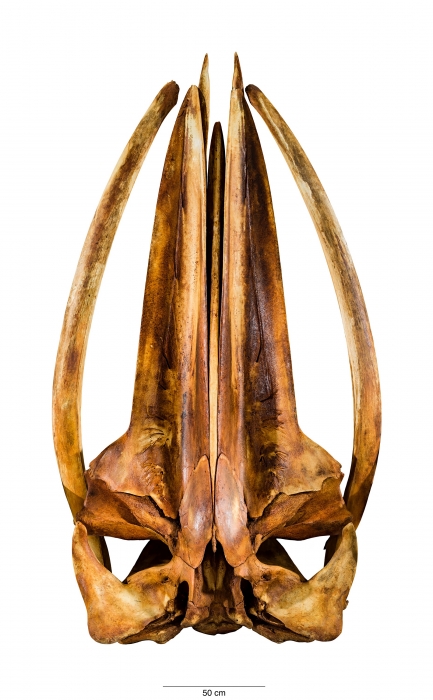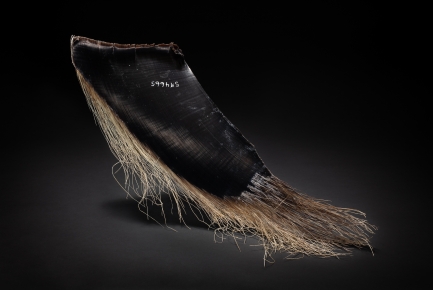The skull of the Rice’s whale skeleton that scientists studied and described to officially designate it as a new species of whale. In the field of biology, scientific recognition of a new species requires what is known as a holotype or type specimen.
Smithsonian To Host Symposium Focused on Endangered Rice’s Whale in Partnership With NOAA, Marine Mammal Commission

A plate of baleen (left) and a plastic shard (right) found in the gut of the first Rice’s whale to be scientifically described.
Credit: James D. Tiller and Fred Cochard, Smithsonian.
The Smithsonian’s National Museum of Natural History will host a scientific symposium focused on the recently identified and endangered Rice’s whale, commemorating the 50th anniversary of the Endangered Species Act and other large whale conservation efforts.
The symposium—to be held at the museum Thursday, Nov. 16, in partnership with National Oceanographic and Atmospheric Administration (NOAA) Fisheries and the Marine Mammal Commission—features experts from the marine mammal research, conservation and management communities. Lectures and discussions will highlight new research as well as how the Marine Mammal Protection Act and Endangered Species Act are aiding the conservation of large whale species like Rice’s whale (Balaenoptera ricei). An exhibit case featuring a plate of baleen and plastic shard found in the gut of the first Rice’s whale to be scientifically described will go on display in the museum’s Sant Ocean Hall Wednesday, Nov. 15.
“This symposium will use the convening power of the Smithsonian to bring together scientists, policy makers, and the public to discuss the recent acknowledgment of the Rice’s whale as a separate species and the conservation issues it poses,” said Michael McGowen, the museum’s curator of marine mammals. “We will also focus on other large whales in U.S. waters, such as the North Pacific right whale that may be lesser known to the public.”
First formally recognized as a new species in 2021, Rice’s whales grow to roughly 40 feet in length, weigh around 30 tons and inhabit the northern Gulf of Mexico year-round. In the 1960s, the whales’ eventual namesake, renowned whale researcher Dale Rice, was the first scientist to note the presence of these large baleen whales in the Gulf. For decades, the scientific assumption was that the whales were a sub-population of Bryde’s whales (pronounced “broodus”). In 2014, NOAA scientists used genetic testing to reveal that the whales’ DNA was sufficiently distinct from other Bryde’s whales to merit the designation of a new species.
Despite this genetic revelation, Rice’s whales could not yet become officially designated as a new species. In the field of biology, scientific recognition of a new species requires what is known as a holotype or type specimen. A holotype is a single specimen that is designated as the official representative of a new species for the entire scientific community. Such a specimen became available in 2019 when responders from the marine mammal health and stranding network recovered a baleen whale that had died and come ashore in Everglades National Park in Florida.
Following a massive effort to transport the decomposing whale, museum specialist John Ososky delivered the complete skeleton to the Smithsonian’s Museum Support Center in Maryland. There, the specimen was carefully examined by Patricia Rosel of NOAA Fisheries and others to formally record the physical characteristics that distinguished this animal from all other whales. This culminated in peer-reviewed research published in 2021 that described the new species and designated the specimen housed at the museum as the species’ holotype.
The museum is the steward of the Rice’s whale holotype for the scientific community. This ensures the specimen’s preservation and accessibility for research in perpetuity. Museum staff and researchers—including Ososky and McGowen—are working to expand scientists’ limited knowledge of the species by studying the chemical makeup of its baleen and by investigating its evolutionary relationships to other whales.
The genetic tests that began the process of identifying the Rice’s whale as its own species also revealed that genetic diversity was low. This is further supported by the estimates of small population size that scientists have gathered from at-sea surveys and acoustic detections. As soon as the Rice’s whale was recognized as a unique species, it was also recognized as one of the most endangered whales on the planet given its small population size with an estimated fewer than 100 individuals remaining. The most significant threats to the species’ survival include human activities like offshore energy exploration and development, oil spills, vessel strikes, ocean noise, marine debris and entanglement in fishing gear.
In light of these numerous threats and the whales’ dwindling numbers, the symposium’s inception was motivated in part by a desire to raise awareness about the plight of this unique whale.
“NOAA Fisheries is proud of the work of our committed scientists to reveal the existence of this unique species to the world,” said Janet Coit, assistant administrator for NOAA Fisheries. “As we recognize the 50th anniversary of the Endangered Species Act this year, we are future-focused on our work to conserve this distinct species and help ensure its survival for generations to come.”
NOAA Fisheries scientists and partners made significant strides to understand Rice’s whales to inform the proposed designation of critical habitat announced earlier this year. The proposal identified specific areas known to be occupied by the whales, encompassing approximately 28,000 square miles of continental shelf and slope-associated waters within the Gulf of Mexico, as critical habitat.
“Thanks to the considerable scientific research and collaboration, we now know that the unique Rice’s whale was overlooked for decades,” said Peter Thomas, executive director of the Marine Mammal Commission. “The United States is a leader in species conservation thanks to the Endangered Species Act and the Marine Mammal Protection Act, and it is our responsibility to protect, conserve and recover species like the Rice’s whale and the North Pacific right whales.”
The symposium will also discuss North Pacific right whales (Eubalaena japonica) and North Atlantic right whales (E. glacialis), which face similar threats from human activities. Speakers will discuss key lessons from conservation efforts that can be shared among these three imperiled species.
Members of the news media interested in attending the Nov. 16 symposium are asked to contact the museum’s press office with the contact information included in the header of this press release.
Event Details
“Whales on the Brink: Stories from the Rice’s Whale Discovery and Right Whale Tales”
Baird Auditorium, National Museum of Natural History, Washington, D.C.
Thursday, Nov. 16; 8:30 a.m.–5 p.m.
Event webpage and symposium livestream link.
# # #
SI-342-2023
Ryan Lavery
202-633-0826
Jack Tamisiea
202-633-0218
Randall Kremer
202-360-8770
Note to editors: Photos of the skull from the skeleton that scientists studied to describe the Rice’s whale as a new species, as well as the plate of baleen and the plastic shard found in the whale’s gut that will be displayed at the museum beginning Nov. 15, are available via Dropbox here (password: whale).




